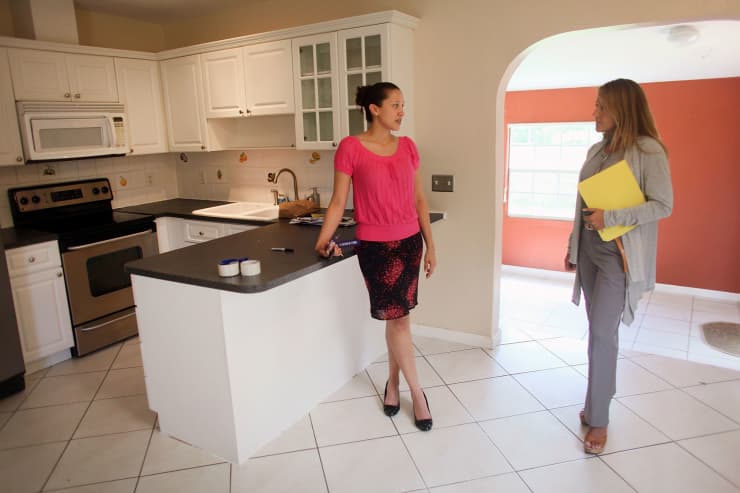- Nationally, prices rose 5.8 percent in August compared with August 2017, according to the S&P CoreLogic Case-Shiller home prices index. That is less than the 6 percent annual gain in July.
- The index’s 10-City Composite rose 5.1 percent annually, down from 5.5 percent in the previous month. The 20-City Composite posted a 5.5 percent year-over-year gain, down from 5.9 percent in the previous month.
- “Following reports that home sales are flat to down, price gains are beginning to moderate,” David M. Blitzer, managing director and chairman of the index committee at S&P Dow Jones Indices, said in a release.

A real estate agent shows a home for sale to a prospective buyer in Miami.Getty Images
Mortgage interest rates didn’t begin their recent surge until the start of September, but home prices were already feeling pressure, as fewer people could afford what was for sale.
Nationally, prices rose 5.8 percent in August compared with August 2017, according to the S&P CoreLogic Case-Shiller home prices index. That is less than the 6 percent annual gain in July.
The index’s 10-City Composite rose 5.1 percent annually, down from 5.5 percent in the previous month. The 20-City Composite posted a 5.5 percent year-over-year gain, down from 5.9 percent in the previous month.
“Following reports that home sales are flat to down, price gains are beginning to moderate,” David M. Blitzer, managing director and chairman of the index committee at S&P Dow Jones Indices, said in a release. “Rising prices may be pricing some potential home buyers out of the market, especially when combined with mortgage rates approaching 5 percent for 30-year fixed rate loans.”

WATCH NOWVIDEO00:46Pending home sales inch up
The jump in mortgage interest rates began at the start of September, but home sales were already slowing, as prices were just too high for some buyers, especially entry-level buyers. Home prices have been pushed higher over the past few years due to a critical shortage of homes for sale. Inventory, however, finally began to rise in August, and continues to gain this fall. Not only are there more listings, but fewer sales, so homes are sitting on the market longer.
The market is beginning to balance more between supply and demand, following one of the strongest seller’s markets in decades. There is little concern, however, that prices will actually fall, only that the gains will fall back to more normal, historical levels of 3 percent to 4 percent annually.
“There are no signs that the current weakness will become a repeat of the crisis, however. In 2006, when home prices peaked and then tumbled, mortgage default rates bottomed out and started a three year surge,” said Blitzer. “Today, the mortgage default rates reported by the S&P/Experian Consumer Credit Default Indices are stable. Without a collapse in housing finance like the one seen 12 years ago, a crash in home prices is unlikely.”
Even as the gains shrink, some local markets continue to show price strength. Las Vegas, San Francisco and Seattle saw the biggest annual gains among the 20-city index.
In August, Las Vegas home prices jumped 13.9 percent year-over-year, followed by San Francisco with a 10.6 percent increase and Seattle with a 9.6 percent gain. Four of the 20 cities reported greater price increases in the year ending August 2018 versus the year ending July 2018.
https://www.cnbc.com/2018/10/30/home-price-gains-fall-below-6percent-for-the-first-time-in-a-year-august-sp-case-shiller-indices.html
